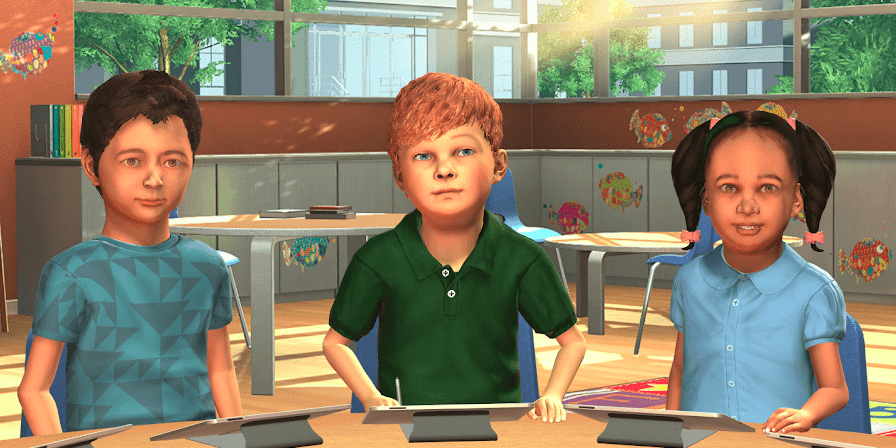This is the second blog post in a two-part blog series on simulations for educator professional development. You can find the first part here.

Teaching isn’t something you can learn just from reading books and listening to lectures. Good teachers have instinctive reflexes and intuitions that go well beyond their declarative knowledge of content and pedagogical theory. Learning to teach well is more like learning to play the piano or basketball than like learning how to read sheet music or recite the rules of the game.
Fortunately, teachers today may have a new helping hand. Enter Mursion, a simulator that school districts can use to give their teachers opportunities to practice tricky teaching scenarios. With Mursion, teachers enter a computer-simulated classroom with virtual students controlled by an actor. After the scenario ends, teachers debrief their responses with a coach from their district to consolidate their learning from the experience.
In our Innovator’s Worth Watching blog series, we analyze whether up-and-coming organizations like Mursion could potentially disrupt the markets they serve. Our interest in disruption is not merely to put bets on the winners and losers. Rather, disruptive innovators are worth watching because they defy the constraints of incumbent organizations and institutions to expand access to products or services with societal value.
In this case, might Mursion have a disruptive trajectory for expanding access to teacher coaching? Below, we put the company and its technology to the test with six questions for identifying potentially disruptive innovations.
1. Does it target nonconsumers or people who are over-served by an incumbent’s existing offering in a market?
Yes. Districts typically don’t offer their teachers much practice-focused professional development. They may have a few instructional coaches on staff, but the cost of those coaches makes it hard to hire enough of them to provide all teachers with frequent observations and feedback. Instead, the available coaches usually offer only occasional consultations or focus on supporting just a subset of a districts’ teachers—such as novices or those with major performance issues.
2. Is the offering not as good as an incumbent’s existing offering as judged by historical measures of performance?
Yes. Teaching in a simulated class of five actor-controlled avatars is not the same as working with a class of 30 real students. A simulated classroom lacks established classroom culture, relationship history, and actual child psychology. Additionally, teachers can’t use physical-presence strategies in a simulation, such as eye contact and proximity.
3. Is the innovation simpler to use, more convenient, or more affordable than the incumbents existing offering?
Is it more convenient? Yes. Mursion saves coaches time they would otherwise have to spend traveling to observe teachers’ classrooms. It also cuts down the amount of time they have to spend in each observation because the simulation can drop teachers right into specific teaching scenarios.
Is it more affordable? Yes. Mursion’s service is affordable compared to the cost of hiring additional coaches to regularly observe and coach every teacher in his or her classroom.
4. Does the offering have a technology enabler that can carry its value proposition around simplicity, convenience, or affordability upmarket and allow it to improve?
Yes. Mursion is working to improve its simulations by building additional practice scenarios and simplifying the hardware required to run the simulations. Going forward, it isn’t hard to imagine the simulations becoming closer approximations of real classroom settings over time through improved avatar graphics, virtual reality, eye-tracking technology, and artificial intelligence.
5. Is the technology paired with a business model innovation that allows it to be sustainable with its new value proposition?
Yes. As Mursion’s business grows, the cost per unit of its software shrinks. The element of Mursion’s business model that remains expensive at scale is the cost of the puppeteer who controls the avatars. But Mursion can justify that cost by helping districts get a higher return on their investment in coaches. Mursion helps coaches save time, thereby making it possible for them to reach more teachers.
6. Are incumbents motivated to ignore the new innovation and not be threatened at the outset?
Unclear. It’s hard to identify who the incumbents are that Mursion might eventually threaten. School districts don’t currently hire any well-established incumbents to provide their teachers with practice-oriented development experiences. They do hire coaches, but Mursion doesn’t replace coaches. Mursion really competes with live classrooms as a place for teachers to get practical experience. But classrooms clearly aren’t going to go away as Mursion improves.
Mursion has many of the tell-tale signs of a disruptive innovation relative to live classroom coaching. But unfortunately, the analysis above falls short on one front. The answer to the first question asserts that Mursion addresses nonconsumption of practice-focused teacher development. But nonconsumption presumes that districts had been actively looking for affordable ways to offer more coaching. In reality, few districts seem pressed to address the paucity of coaching, and Mursion has, therefore, had a hard time selling to districts. If districts do not see Mursion as a way to increase access to coaching, and instead frame it as just another alternative form of teacher professional development, then Mursion competes head-to-head with other professional development providers for the district’s fixed pool of professional development dollars.
Fortunately, there may be other disruptive prospects for Mursion among other customers and applications. Mursion’s primary education customers are schools of education that hire Mursion to help them improve the practice-oriented aspects of their teacher preparation programs. Additionally, Mursion has found its best customers by adapting its simulations for healthcare organizations, corporate training, and the defense industry. As Mursion continues to improve its services and explore new avenues for its business model, it will be interesting to see how its innovation story continues to unfold.



